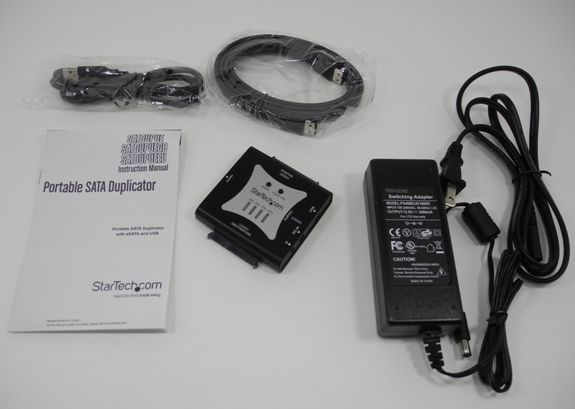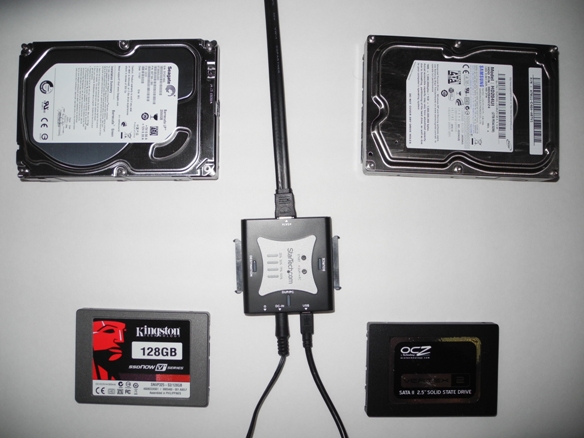StarTech.com Portable SATA Duplicator & USB / eSATA Dock Review
by Ganesh T S on September 6, 2011 6:50 PM EST- Posted in
- Gadgets
The SATDUPUE package contained the following:
- Portable SATA duplicator / dock
- 36W power adapter
- eSATA - eSATA cable
- USB 2.0 A Male to Mini-B 5 pin Male cable
- Instruction manual
Before getting into the test setup and benchmarking process, it is important to understand the usage and limitations of the product.
In the dock mode (default, green mode status LED), connecting two drives will result in a JBOD configuration (2 distinct disks visible to the PC). However, this is only through the USB port. If seen through the eSATA port, only the drive connected to the destination is seen (unless the PC's eSATA port supports port multipliers). When both USB and eSATA are connected, USB takes preference.
The product can be put into the duplicator mode (red mode status LED) by keeping the mode button pressed for 3 seconds. In this mode, the drive connected to the destination must be of equal or higher capacity compared to the drive connected to the source port. In our testing, we made sure that there was no EISA partition in the source drives. StarTech.com specifically mentions that the EISA partition must be removed prior to duplication.
Our test setup consisted of the following:
- SATDUPUE
- Seagate Barracuda LP 2000 GB 3.5" Hard Drive [ ST2000DL003 5900 rpm 64MB ]
- Samsung EcoGreen 2 TB 3.5" Hard Drive [ HD204UI 5400 rpm 32 MB ]
- OCZ Vertex 2 OCZSSD2-2VTX120G 2.5" 120GB SSD
- Kingston SSDNow V+ Series SNVP325-S2/128GB 2.5" 128GB SSD
For testing the dock functionality, the OCZ Vertex 2 drive was hooked up to a 6 Gbps SATA port in the ASRock CoreHT 252B's HM65 based motherboard as a secondary drive. The eSATA port in the CoreHT 252B unfortunately doesn't support the port multiplier function.
Two sets of tests were performed, one in DOCK mode and the other in DUPLICATOR mode. All the tests involved transfer of the HQV 2.0 Benchmark Blu-ray folder backup (11.37 GB Blu-ray folder structure) using the robocopy command in mirror mode. While the stress was on transfer rate measurements, the duplicator mode also offered interesting insights into the power consumption and temperature factors.
In the next section, we will look at the benchmark results and present our conclusions.


















36 Comments
View All Comments
ganeshts - Wednesday, September 7, 2011 - link
Bad sectors are skipped, so you do get the good data. In case of a failed drive, this is not a suitable product for that (look at my comment in reply to mariush's post above)Samus - Thursday, September 8, 2011 - link
needs usb 3.0 :(pandemonium - Friday, September 9, 2011 - link
I'm impressed. Not particularly since this is a nicely done niche product, but the fact that they market the speeds less than what they actually did in the bench. That's admirable.7Enigma - Monday, September 12, 2011 - link
Agreed! Nice bit of honest marketing for once.mozozozo - Sunday, September 11, 2011 - link
Does anyone know of a software HDD Duplicator that can do more than 1:1 cloning, say 1 master to 3 slave etc. I know there are PC independent hardware solutions but they are quite expensive.If the software is available one could built a cheap 3 hdd duplicator with a basic 4 sata port motherboard.jonathan1683 - Saturday, September 17, 2011 - link
I would like to state my thoughts as well on the article since I have never seen a device like this and it actually made me want one. After the review I really didn't know exactly what it did and I do not agree with the person said that you shouldn't put info that was available elsewhere. I would rather read it in the review so thanks for keeping the info. Maybe if people really dislike it you can have a manufacturer info paragraph so people can decide not to read it. I think it should have given more info on to what it did. I think the article assumed I knew what devices like this do. I understand somewhat what it does, but I still think I need to visit their site to understand completely. I think just the words hard drive duplicator would have been helpful. I thought it was duplicating interfaces to do IDE to USB functions. I also agree with mariush these questions are valid and I would have also liked to know how stable it worked with a bad drive and I would also have liked you to include your personal opinion on the power supply because it was the first thing that deterred me from buying it. If you include info like this in your review it would prompt manufacturers to make smaller devices. Why do they even need power bricks this big for such a small device? The fact that you actually tested the device and thought what we were thinking should give you reason to add it in the review because you had the same thoughts and questions. Also I thought the comment was dumb that someone asked if it could do a function like acronis migrate easy when it cloned data to a bigger size drive because the review said it could use larger drives I assumed it could. I thought it was great, but it actually doesn't and you would have to make a new partition which to me make is not what I would want. The info about the unallocated space should have been included. Anyways this is getting too long. This is my first time on the site and I am reading almost every article. Great site and thanks for the review.